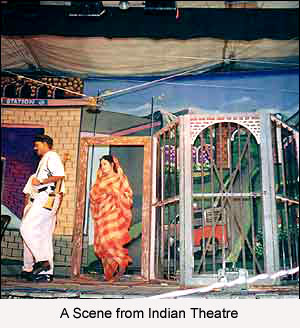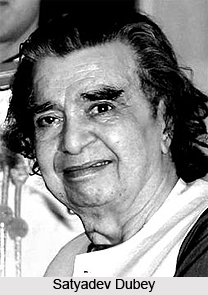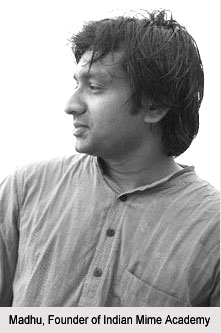 Indian theatre laced with its entire magic, dream, colour and passion gradually restructured the progress of Indian art and culture to a great extent. The eminent personalities in Indian drama right from the ancient age to the contemporary times have offered a distinct shape to the Indian theatre. The glory of the Sanskrit plays which was once a prominent part of the Indian theatre in the ancient age somewhat faded away during the medieval time. The essence of the theatre pattern that was there in the Vedic and ancient era was further rationalized to befit the requirements of the medieval era. Sanskrit theatre which flourished in the ancient age received somewhat a serious setback during the medieval period and the renowned personalities in Indian theatre (Medieval age) offered a fresh enunciation to the existing theatre pattern.
Indian theatre laced with its entire magic, dream, colour and passion gradually restructured the progress of Indian art and culture to a great extent. The eminent personalities in Indian drama right from the ancient age to the contemporary times have offered a distinct shape to the Indian theatre. The glory of the Sanskrit plays which was once a prominent part of the Indian theatre in the ancient age somewhat faded away during the medieval time. The essence of the theatre pattern that was there in the Vedic and ancient era was further rationalized to befit the requirements of the medieval era. Sanskrit theatre which flourished in the ancient age received somewhat a serious setback during the medieval period and the renowned personalities in Indian theatre (Medieval age) offered a fresh enunciation to the existing theatre pattern.
It is during the fag end of the 16th century and with the colossal maturity of the style of the Indian classical dance drama theatre in medieval India gained its desired contour. In the eastern part of Bengal, King "Laksmanya Manikya was ruling then. He was the ruler of Bhulula the East Bengal. Theatre, dance, mime and dance form all ideally merged during this time to form a whole new type of Indian drama that has been later classified as the theatre pattern of the medieval era. The ardent art lover and the great theatre enthusiast King Laksmanya Manikya composed two plays namely Vikhyata-Vijaya and Kuvalayashva-charita. Another great personality of Indian theatre during the medieval age was "Kavitarkik" who was the court poet of King Laksmanya Manikya. One of the most striking creations of Kavitarkik was Kautuka-ratnakara and it still bears that tinge of contemporaneousness amidst its artistry and style. Mythological plays and classical historical dramas largely made their presence felt and were the elementary base of the typical theatrical pattern of medieval India. The study of personalities in Indian theatre (medieval age) is somewhat incomplete without the name of Krishnachandra Roy who was then the tributary king of Nabadweep. He was the one who further patronized theatre to a large extent and India especially West Bengal witnessed the remarkable influence of Sanskrit dramaturgy amidst the creative plays like Chandi, Mahisasura Vadha and Chitra-yajn.
 Translations of Sanskrit play and texts continued to be in demand till the beginning of the 19th century. It is during this era, renowned playwrights like Krisahna Mishra Yati, Kalidasa, Panchanan Tarkaratna and Kalipada Tarkicharya further enriched the Indian theatre with their colossal artistry and vision. Plays like Nala-damayantiya and Syamantakoddhar by Kalipada Tarkacharya, Kirtibilas by Jogendranath Gupta added that rich facet to Indian theatre.
Translations of Sanskrit play and texts continued to be in demand till the beginning of the 19th century. It is during this era, renowned playwrights like Krisahna Mishra Yati, Kalidasa, Panchanan Tarkaratna and Kalipada Tarkicharya further enriched the Indian theatre with their colossal artistry and vision. Plays like Nala-damayantiya and Syamantakoddhar by Kalipada Tarkacharya, Kirtibilas by Jogendranath Gupta added that rich facet to Indian theatre.
Eminent personalities in Indian theatre (Medieval age) further made theatre in India not only an art form but slowly crafted it as the refined technique of illustrating the realities of life in the form of "Rupaka" and "Natya". It is during the end of the medieval period a whole new genre of theatre known as the "indigenous theatre", emerged. Theatre then gradually broke the barrier of mythology, history and epoch. The echo of the age old Sanskrit plays also faded away, Classical dance drama style was then largely modernized. Dance, instrumental music, speech furnished on lyrics, verses and prose then laced the Indian theatre whilst making it an expression of the creative minds.
 Theater Personalities of Ancient India
Theater Personalities of Ancient India
Indian theatre is as old as the culture of India and quite ideally therefore the deep-rooted relation between Indian tradition and Indian drama has given birth to a number of eminent personalities in Indian theatre. India therefore boasts its glorious association with all the well known theatre personalities who has further reshaped and redefined the age old ethnicity of India in the most coherent way. What we get to see these days as the Indian drama therefore has a rich chronology of its own. The copious saga of Indian drama holds the fact that it is in the ancient age of the Vedic period the contour of Indian drama was delineated for the very first time.
Theatre Personalities during British Rule
Theatre which was primarily just a means of entertainment during medieval India later gained a concrete shape during the British rule. Why only drama! Almost every literary expression then became the weapon to illustrate the effects and impacts of the British Raj. Quite ideally therefore Indian theatre during the British rule became lot more contemporary. It can be therefore easily said that the 200 years of British Imperialism brought Indian art and artistry into close contact with the European fervour and hence in India, developed a new artistic form.
Theater Personalities of independent India
The renowned personalities in Indian theatre after independence further reshaped the haphazard form of Indian "natya" and made it rather contemporary. The seed of modern drama was sown during the time of the British rule and therefore quite ideally the typical theatre form, right after the independence became lot more modish to befit the existing political and economic scenario of independent India.




















